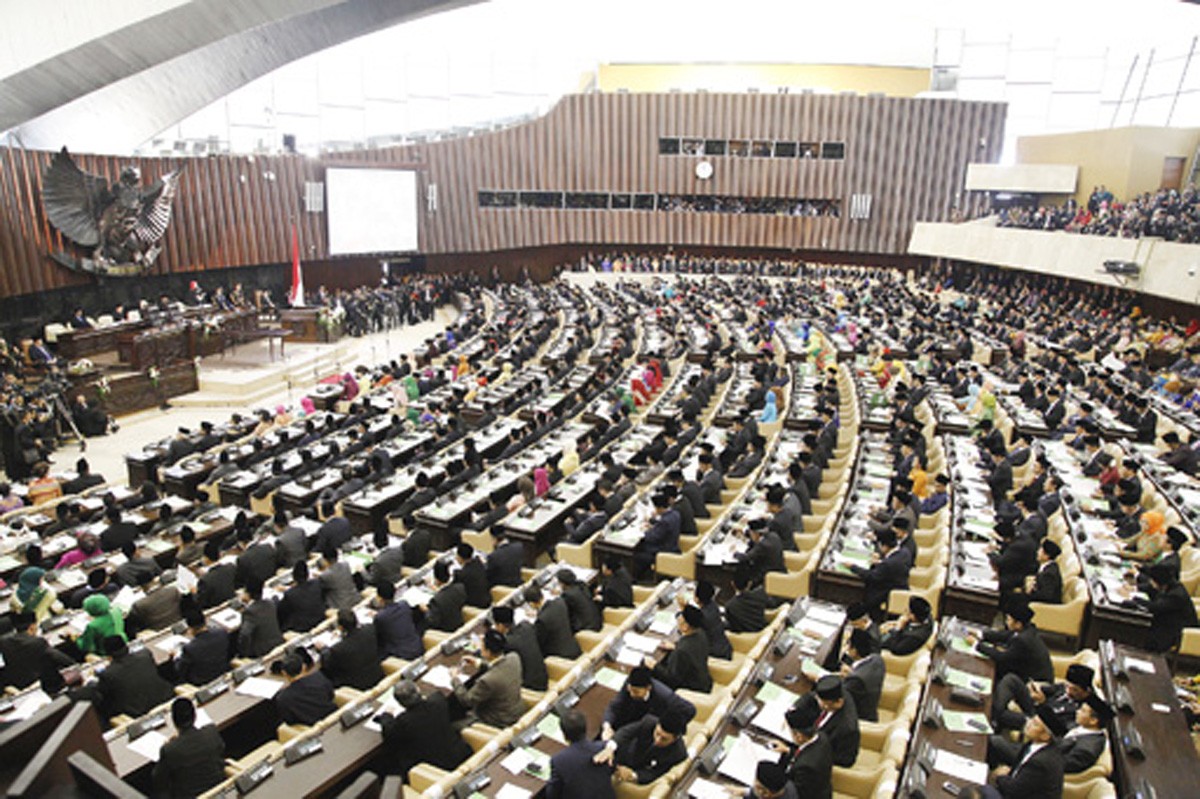Popular Reads
Top Results
Can't find what you're looking for?
View all search resultsPopular Reads
Top Results
Can't find what you're looking for?
View all search resultsMPR plan comes under fire
Change text size
Gift Premium Articles
to Anyone
 The 560 House of Representatives (DPR) and 132 Regional Representatives Council (DPD) members, who together make up the People'€™s Consultative Assembly (MPR), attend their inauguration ceremony at the House in Jakarta on Wednesday. The swearing-in ceremony was marred by squabbling among political parties over new House leadership election procedures. (JP/Awo)
The 560 House of Representatives (DPR) and 132 Regional Representatives Council (DPD) members, who together make up the People'€™s Consultative Assembly (MPR), attend their inauguration ceremony at the House in Jakarta on Wednesday. The swearing-in ceremony was marred by squabbling among political parties over new House leadership election procedures. (JP/Awo)
F
ourteen years after the last amendment, the People’s Consultative Assembly (MPR) has started the process of amending the 1945 Constitution, setting the stage for a battle among political parties that could end up transforming the country’s political system.
The MPR, which under the New Order regime served as the highest law-making institution in the country, could regain its power in the drafting of the state policy guidelines (GBHN), the guidance for long-term development plans that the president must implement.
According to a proposal drafted by the MPR assessment agency, a team jointly established by the Regional Representatives Council (DPD) and four political party factions at the House of Representatives, two options are available to allow for the change: amending the constitution to grant the MPR the authority to issue the guidelines through an MPR decree, or inserting the concept of GBHN-like guidelines into an article of the 1945 Constitution.
The two largest political factions at the House, the Indonesian Democratic Party of Struggle (PDI-P) and the Golkar Party, back the first proposal.
“Amending the Constitution to grant the MPR more authority will make it a stronger legal instrument,” PDI-P deputy secretary-general Achmad Basarah said.
With the authority to draft GBHN, the MPR would have a greater mandate than that of the president and could sanction the latter for failing to implement the guidelines.
Between 1999 and 2002, soon after the fall of president Soeharto, the MPR amended the Constitution four times in an attempt to limit the power and authority of the president. The amendment also allowed for greater checks and balances among state bodies by redistributing power among the executive, legislative and judicial branches of the government.
By reinstating the GBHN, the MPR plans to elevate itself again as the highest law-making institution in the country, above the president and able even to impose control over the government, a system very different to the current presidential system.
Constitutional law expert Feri Amsari, a researcher at the Center of Constitutional Studies at Andalas University in Padang, West Sumatra, said that the plan, if endorsed, could mean the introduction of a parliamentary system, which he claimed would be unsuitable.
“Our political tradition is not ready to bring back the parliamentary system because the executive branch of the government would be prone to instability. The presidential system brings more stability because it regulates a fixed tenure for the executive body,” Feri said.
Political expert Ramlan Surbakti from Airlangga University in Surabaya, East Java, said there was no need to amend the Constitution or grant more power to the MPR, as the country’s political system centers on the executive.
Ramlan recommended that the GBHN be inserted into the Constitution.
“Amending the 1945 Constitution will consequently bring back power to the MPR as the highest branch of government. We still have no idea what consequences this will have. Who will oversee the MPR in the future?” he asked.
The proposal for bringing back the GBHN was first aired by PDI-P chairperson Megawati Soekarnoputri, daughter of president Sukarno, who first came up with the idea of guiding principles for the country’s government. But it was Sukarno’s successor, Soeharto, who made the plan reality in 1969, soon after he took the reins of power from the country’s founding president.
In the post-Soeharto era, the MPR could threaten to use the GBHN to impeach a president who did not effectively implement development policy; transitional president BJ Habibie decided not to seek another term after his accountability report was rejected by the MPR in 1999.
A constitutional amendment in 2001 removed the MPR’s status as the highest state institution and axed the GBHN altogether.
Under the current presidential system, a move against the president in the form of an impeachment proceeding can only occur if the House launches an inquiry, requesting detailed examination of a policy, and only when the policy in question meets the criteria for violations that could be subject to an impeachment trial can the process start.
Currently, of the 10 factions at the House, only the Democratic Party opposes the GBHN plan.
“The president and vice president are directly elected by the people. They present their vision and mission to the people. So why should they have to follow the guidelines made by the MPR?” party deputy chairman Syarifuddin Hasan asked.
______________________________
To receive comprehensive and earlier access to The Jakarta Post print edition, please subscribe to our epaper through iOS' iTunes, Android's Google Play, Blackberry World or Microsoft's Windows Store. Subscription includes free daily editions of The Nation, The Star Malaysia, the Philippine Daily Inquirer and Asia News.
For print subscription, please contact our call center at (+6221) 5360014 or subscription@thejakartapost.com









